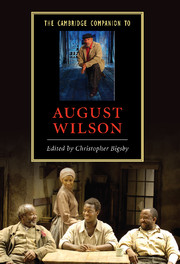Book contents
- Frontmatter
- 1 August Wilson: the ground on which he stood
- 2 Been here and gone
- 3 August Wilson’s relationship to black theatre: community, aesthetics, history and race
- 4 Music and mythology in August Wilson’s plays
- 5 Gem of the Ocean and the redemptive power of history
- 6 Joe Turner’s Come and Gone
- 7 Ma Rainey’s Black Bottom: cutting the historical record, dramatizing a blues CD
- 8 A piano and its history: family and transcending family
- 9 The tragedy of Seven Guitars
- 10 Safe at home?: August Wilson’s Fences
- 11 Two Trains Running: blood on the tracks
- 12 Jitney, folklore and responsibility
- 13 King Hedley II: in the midst of all this death
- 14 Radio Golf: the courage of his convictions - survival, success and spirituality
- 15 Critics on August Wilson
- 16 An interview with August Wilson
- Index
3 - August Wilson’s relationship to black theatre: community, aesthetics, history and race
Published online by Cambridge University Press: 28 January 2008
- Frontmatter
- 1 August Wilson: the ground on which he stood
- 2 Been here and gone
- 3 August Wilson’s relationship to black theatre: community, aesthetics, history and race
- 4 Music and mythology in August Wilson’s plays
- 5 Gem of the Ocean and the redemptive power of history
- 6 Joe Turner’s Come and Gone
- 7 Ma Rainey’s Black Bottom: cutting the historical record, dramatizing a blues CD
- 8 A piano and its history: family and transcending family
- 9 The tragedy of Seven Guitars
- 10 Safe at home?: August Wilson’s Fences
- 11 Two Trains Running: blood on the tracks
- 12 Jitney, folklore and responsibility
- 13 King Hedley II: in the midst of all this death
- 14 Radio Golf: the courage of his convictions - survival, success and spirituality
- 15 Critics on August Wilson
- 16 An interview with August Wilson
- Index
Summary
Before the Harlem Renaissance of the 1920s and 1930s, the Federal Theatre Project (1935-9), and the American Negro Theatre and the Negro Playwrights' Company in the 1940s, where was black theatre? There were minstrel shows conceived by whites and performed by whites in black face in the early nineteenth century, such as E. P. Christy's Minstrels. Then, after the Civil War, black actors were seen on stage performing in such shows as Haverly's Colored Minstrels. Undeniably, however, these, whether performed by white or by black actors, perpetuated derogatory caricatures of African Americans. Before minstrel shows there were plays written by black playwrights, but their titles and creators are not well-known to most American theatregoers: James Brown's King Shotaway (1823), William Wells Brown's Escape, or Leap of Faith (1858) and Angelina W. Ginkle's Rachel (1916). In the 1920s Willis Richardson's The Chipwoman's Fortune (1923) and Garland Anderson's Appearances (1925) reached the Broadway stage, still the 'Great White Way' (although this was a reference to the lights on theatre marquees, it had a symbolic truth with respect to race), but these, too, were beset by ubiquitous caricatures. In the 1930s, though, Langston Hughes's play Mulatto (1935) achieved considerable success, focusing in a serious way on racial identity and establishing a record run for a black play on Broadway not beaten until Lorraine Hansberry's A Raisin in the Sun (1959). The latter constituted a crucial moment in black theatrical history, launching the career of a number of black actors and that of a man who would go on to direct August Wilson's plays, Lloyd Richards, the first African American to direct a Broadway play.
- Type
- Chapter
- Information
- The Cambridge Companion to August Wilson , pp. 52 - 64Publisher: Cambridge University PressPrint publication year: 2007



